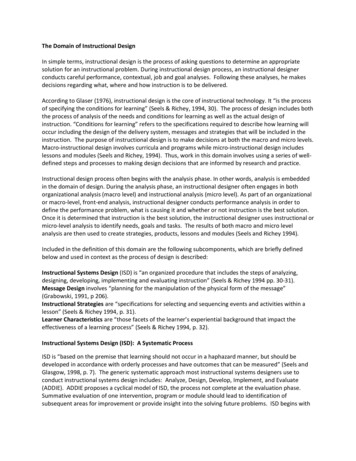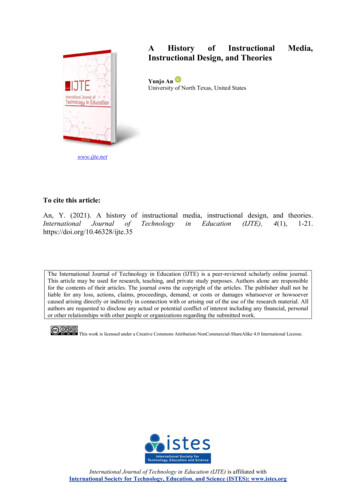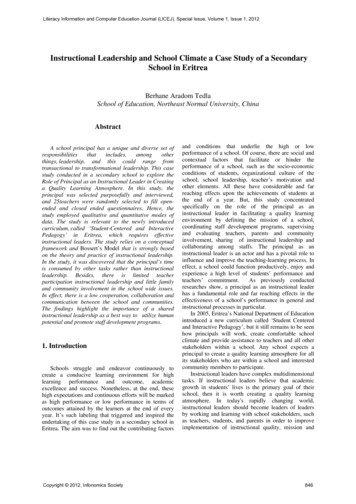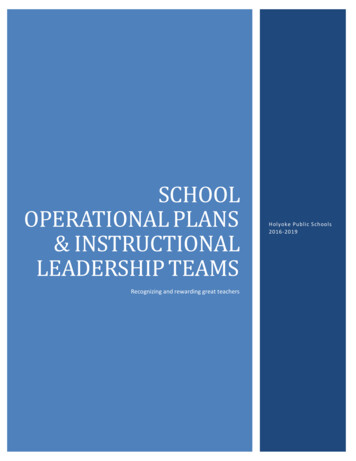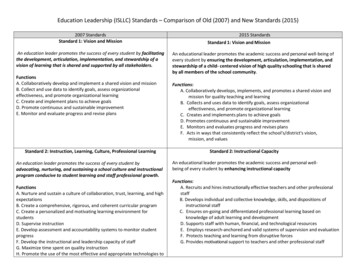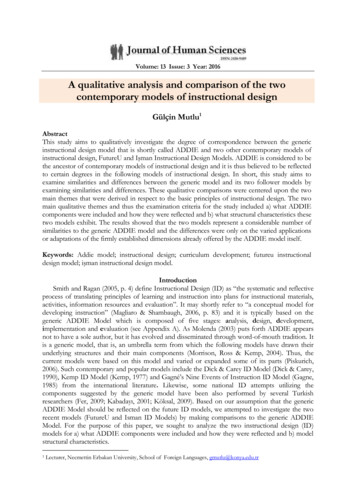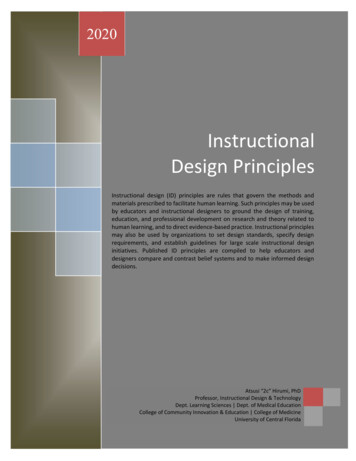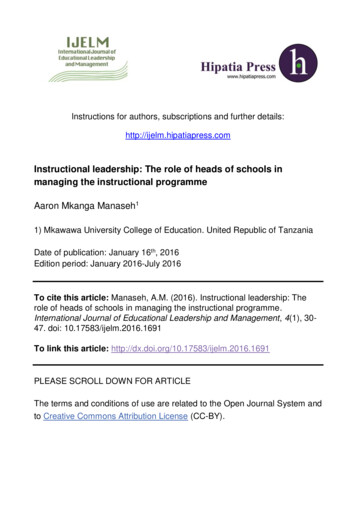
Transcription
Instructions for authors, subscriptions and further details:http://ijelm.hipatiapress.comInstructional leadership: The role of heads of schools inmanaging the instructional programmeAaron Mkanga Manaseh11) Mkawawa University College of Education. United Republic of TanzaniaDate of publication: January 16th, 2016Edition period: January 2016-July 2016To cite this article: Manaseh, A.M. (2016). Instructional leadership: Therole of heads of schools in managing the instructional programme.International Journal of Educational Leadership and Management, 4(1), 3047. doi: 10.17583/ijelm.2016.1691To link this article: http://dx.doi.org/10.17583/ijelm.2016.1691PLEASE SCROLL DOWN FOR ARTICLEThe terms and conditions of use are related to the Open Journal System andto Creative Commons Attribution License (CC-BY).
IJELM – International Journal of Educational Leadership andManagement Vol. 4 No. 1 January 2016 pp. 30-47Instructional Leadership: TheRole of Heads of Schools inManaging the InstructionalProgrammeAaron Mkanga ManasehMkawawa University College of EducationAbstractScholars and practitioners agree that instructional leadership (IL) can be one of themost useful tools for creating an effective teaching and learning environment. Thispaper investigates the instructional leadership practices engaged in by heads ofsecondary schools to enhance classroom instruction and students learning,particularly the way they manage the school instructional programme. Twoobjectives guided the study: to explore the informants’ understanding on the conceptof IL; and to examine the role played by heads of schools (HoSs) in managing theinstructional programme to enhance teachers’ classroom instruction and students’learning. It draws on the qualitative data generated from interviews, focus groupdiscussions, and observations. The informants for this study were HoSs, senioracademic masters/mistresses (SAMs), teachers and students. The study findingsconfirm that HoSs, SAMs, teachers and students were not familiar with the conceptof IL. On the other hand, the instructional programme was not effectively managedas heads of departments were not involved in curriculum coordination, syllabi werenot covered on time, and HoSs did not undertake classroom observations or engagein review of curriculum materials. The paper, however, concludes that without aneffective management of the instructional programme in favour of promotingteachers’ classroom instruction and students’ learning, efforts to that effect aredoomed to fail.Keywords: instructional leadership, instructional programme, qualitative datainquiry, Tanzania2016 Hipatia PressISSN: 2014-9018DOI: 10.17583/ijelm.2016.1691
IJELM – International Journal of Educational Leadership andManagement Vol. 4 No. 1 January 2016 pp. 30-47Liderazgo Instructivo: El Papelde los Directores de Escuela enla Gestión del Programa deInstrucciónAaron Mkanga ManasehMkawawa University College of EducationResumenAcadémicos y profesionales están de acuerdo en que el Liderazgo Instructivo (IL)puede ser una de las herramientas más útiles para una enseñanza eficaz y unambiente de aprendizaje. Este trabajo investiga las prácticas de IL aplicadas pordirectores de escuelas de secundaria para mejorar la enseñanza en clase y elaprendizaje de los estudiantes, en concreto, la forma cómo se gestiona el programade instrucción escolar. Dos objetivos guiaron el estudio: explorar la comprensión delos informantes del concepto de IL; y examinar el papel de los directores de lasescuelas en la gestión del programa de instrucción para mejorar la enseñanza de losprofesores en el aula y el aprendizaje de los estudiantes. Se basa en datoscualitativos a través de entrevistas, grupos de discusión y observaciones. Losinformantes fueron directores de escuela, profesores veteranos, profesores yestudiantes. Los resultados del estudio confirman que ninguno de ellos estabafamiliarizado con el concepto de IL. Por otro lado, el programa de instrucción noestaba gestionado eficazmente ya que los jefes de departamento no estabaninvolucrados en la coordinación curricular, los programas de estudio no se cubrían atiempo y los directores no llevaban a cabo observaciones en el aula o revisiones delos materiales curriculares. El estudio concluye que sin una gestión eficaz delprograma de instrucción para promover la enseñanza en el aula y el aprendizaje delos estudiantes, los esfuerzos están condenados al fracaso.2016 Hipatia PressISSN: 2014-9018DOI: 10.17583/ijelm.2016.1691
32Manaseh, A.M. – Instructional LeadershipPalabras clave: liderazgo instructivo, programa de instrucción, investigacióncualitativa, TanzaniaGlobally, scholars agree that instructional leadership (IL) is one of themost useful tools for creating an effective teaching and learningenvironment (Pustejovsky, Spillane, Heaton & Lewis, 2009;Hallinger & Walker, 2014). In Tanzania, for example, the Ministry ofEducation and Vocational Training (MoEVT) (2011) through the secondaryeducation development programme II document, stipulated that, amongother duties, heads of secondary schools would be responsible forsupervising the teaching programme, ensuring high quality teaching andlearning, effective use of time for the entire school day and a conduciveteaching and learning environment.Instructional leadership is an educational leadership that focuses on thecore responsibility of a school, namely teaching and learning, by definingthe school vision, mission and goals, managing the instructional programmeand promoting the school climate (Hoy & Miskel, 2008). King (2002)asserted that the role of an instructional leader differs from that of atraditional school administrator in a number of meaningful ways: whereasthe conventional head of school spends majority of his/her time dealingstrictly with administrative duties, the head of school who is an instructionalleader is charged with redefining his/her role to become the primary learnerin a community striving for excellence in education. As such, it becomes thehead of school’s responsibility to work with teachers to manage theinstructional programme. Instructional leaders know what is happening inthe classrooms and develop the capacities of their staff by building on theirstrengths and reducing their weaknesses (Spillane & Zuberi, 2009).Instructional leaders go beyond the traditional role of schooladministrators and spend a lot more time focusing on developing knowledgeand implementation of the curriculum, as well as instruction and assessment(Jita, 2010). The paper argues that improvement in learning is more likely tobe achieved when the leadership is instructionally focused and locatedclosest to the classroom. Despite the fact that IL is significant in promotingteachers’ instructional practices and students learning, literature has shownthat HoSs in Africa and Tanzania in particular, rarely engage in IL(Lwaitama & Galabawa, 2008; World Bank, 2010). IL as described asoverseeing ‘teaching and learning’ and ‘supervising teachers’ is not a
IJELM– International Journal of Educational Leadership & Management, 4(1)33function that takes up the majority of many HoSs’ time. Furthermore, therecent researches on school leadership in Tanzania indicate that little hasbeen devoted in studies relating to IL, particularly the engagement of HoSsin IL.Purpose of the StudyThis study aimed at establishing the current IL practices of heads ofsecondary schools in managing the instructional programme.Specific ObjectivesThe specific objectives of this study were:i. To explore the informants’ understanding on the concept ofinstructional leadership.ii. To examine the role played by heads of schools in managing theinstructional programme to enhance teachers’ classroom instructionand students’ learning.Research QuestionsThe following questions guided the inquiry:i. How do informants understand the concept of instructionalleadership?ii. What role do heads of school play in managing the instructionalprogramme to enhance teachers’ classroom instruction and students’learning?Literature ReviewThe literature surveyed indicated that IL is a significant factor in facilitating,improving and promoting teachers’ classroom instructional practices and theacademic progress of students (Spillane, Camburn & Pareja, 2007;Pustejovsky, Spillane, Heaton & Lewis, 2009; Spillane & Zuberi, 2009).International empirical studies also affirm that IL plays a central role inshifting the emphasis of school-level activities more onto instructionalimprovements that lead to students learning better (Elmore, 2000; Spillane,
34Manaseh, A.M. – Instructional LeadershipHalverson & Diamond, 2000; Day, Harris, Hadfield, Tolley & Beresford,2000; King, 2002). For example, McEwan (2009) through a synthesis ofeffective schools research in the United States of America developed tentraits of effective schools. The first ranked trait was that in academicallysuccessful schools strong instructional leadership was displayed.However, in Australia Gillet (2010) interviewed heads of twentysecondary schools and found that their work had intensified over the periodand had increasingly focused on financial administration to the exclusion ofinstructional leadership. Their work was more directed towards managerialissues rather than responding to instructional activities, all of whichdistanced HoSs from their staff and learners. In the same vein, in CanadaHallinger (2005) found that most HoSs often find themselves without thetime, expertize or inclination to engage in hands-on supervision of classroominstruction. Even in smaller elementary schools, where head teachers aremore likely to engage in this aspect of IL, the separation between headteacher and classroom remains strong.In developing countries such as Uganda, Galabawa and Nikundiwe(2000) found that IL instilled the spirit of hard working in students anddedication on the part of teachers. It also enabled the maximum cooperationbetween parents and administrators, which eventually paved the way forbetter discipline, effective management and counselling. The result wasdecorum and a good atmosphere for learning, the best students were selectedat the national level, and there were sufficient teachers as well as access tofacilities such as laboratories and libraries. Furthermore, Hoadley, Christie,Jacklin and Ward (2007) in their study on ‘Managing to learn: Instructionalleadership in South African secondary schools found that HoSs reportedspending most of their time on administrative functions and disciplininglearners. IL in terms of overseeing ‘teaching and learning’ and ‘supervisingteachers’ was not a function that took up the majority of many school heads’time.In the Tanzanian context, Sumra and Rajan (2006) found that teachers insecondary schools are seldom in the classroom interacting with students;they are either away or in the staffroom. A study by the World Bank (2010)supported this by showing that Tanzanian teachers spend less time teachingthan others worldwide, and there is no evidence to suggest this situation mayhave significantly improved. When in the classroom most teach using rotetechniques requiring students to copy and memorize notes on the board.
IJELM– International Journal of Educational Leadership & Management, 4(1)35According to Lwaitama and Galabawa (2008) these inefficiencies at schoollevel seem to result from the lack of effective teacher management andsupervision. Heads of schools are not facilitated or provided withsupervisory skills to ensure that they carry out the role of instructionalleaders of fellow teachers in schools.However, recent researches by Nguni (2005), Ngirwa (2006) and theWorld Bank (2010) in the area of leadership in the Tanzanian contextindicated that very little attention has been devoted to IL, particularly the ILpractices engaged in by heads of secondary schools. The World Bank (2010)suggested that a study should be conducted at school level to reveal theHoSs’ engagement in IL. This study sought to fill this gap by analysing theIL practices that heads of secondary schools engage in to enhance teachers’classroom instruction and students’ learning.Methodological Approach to the InquiryThis study drew on the qualitative inquiry. Relying primarily on a qualitativeframework, the study deployed a case study design. The need for a detailedexploration of IL practices engaged in by heads of schools and their in-depthexamination within a specific context of secondary schools made thisunderlying design indispensable. The data collection methods deployed wereinterviews (face-to-face semi-structured), focused group discussions(FGDs), and observation (participant). These methods were chosen to crossvalidate the data obtained from each method. Both primary and secondarysources of data were employed in data collection. Primary data werecollected from key informants through interview, FGDs and observations.Interviews enabled to probe further to obtain more detailed informationfrom participants. FGDs, on the other hand, opened a room for diverseviews. In fact, participants tend to provide checks and balances on eachother, which weeds out false or extreme views. Observations were vital forgaining knowledge concerning ‘theory-in-use’ and the perspectives that theinformants were reluctant to directly state in interviews and FGDs.Additionally, observations allowed the researcher to record the naturalbehaviour of HoSs in their social settings.The data so collected were analysed thematically. The process of dataanalysis began at the outset of field work, focusing on transcribedinterviews, field notes made during and after interviews, and on
36Manaseh, A.M. – Instructional Leadershipobservations. Three main stages informed data analysis (Huberman & Miles,1994). Firstly, data reduction involved transcribing and summarising datafrom all sources. Data reduction was done on a daily basis. This enabled theresearcher to assess the methods and strategies of data generation, and tomake adjustments accordingly. Secondly, there was further organization ofthe reduced data, in terms of generating major themes and sub-themes fromoral and written texts.Sampling DesignThe study involved six secondary school (SSs), a total of 36 informantsparticipated in the study; they included six HoSs, six Senior AcademicMasters/Mistresses (SAMs), twelve teachers and twelve students. Bothinformants and the schools were purposively selected. The study wasconducted in Iringa urban. The selected study area was particularly usefulbecause it had mixed characteristics of IL practices; some HoSs engaged inIL while others did not.Findings and DiscussionPresentation and discussion of the findings drew upon two researchquestions: (1) How do informants understand the concept of instructionalleadership? (2) What role do heads of school play in managing theinstructional programme to enhance teachers’ classroom instruction andstudents’ learning?Informants’ Understanding of Instructional LeadershipThrough interview, HoSs were asked to respond to this question: “Howfamiliar are you with the idea/concept of IL? The findings from interviewwith HoSs indicated that six out of six (100 percent) HoSs were not familiarwith the idea of IL. They said it was a new concept to them. One head ofschool said: “To be honest instructional leadership is a new term to mebecause I have not heard of it before” (Head of School).To find out the HoSs’ understanding of IL, they were asked: “How wouldyou describe IL? The findings revealed that five out of six (83%) HoSs wereable to articulate many aspects of IL functions. They claimed that IL is a
IJELM– International Journal of Educational Leadership & Management, 4(1)37kind of leadership that is targeted more on instruction and learning. In theinterview one HoS said:I think instructional leadership is a kind of school leadership that isfocused on teaching or instruction. It means prioritizing instructionalpractices over managerial duties .being in the classroom talking tolearners and discussing their work, asking them questions about theirstudies and how they are helped (Head of school).This quotation shows that, despite the fact that IL was a new idea toheads of schools, majority were able to conceptualize it. However, one HoShad no understanding of IL.Further, interviews with six SAMs revealed similar views. They said ILensures that there is effective teaching and learning in school. They addedthat instructional leaders are facilitators in the sense that they are able toassist others in the teaching and learning process, and are able todemonstrate teaching techniques in the classroom and during generalmeetings with teachers. One senior academic master said: “[ ] well, when Ithought that I thought instructional would be giving guidance orgiving instructions but at the same time being an example of it, you know learning by example”.Teachers during interview expressed that IL concerns HoSs taking careof how teachers teach and the way students learn. One teacher said: “ inmy view, IL means school leadership that takes much care on teachers’instruction and the way students learn” (School teacher). The findings fromFGDs with students revealed that they were not familiar with the concept ofIL and were not able to explain what it is. One of the students in FGDs said:“[ ] Oh! I have not heard about instructional leadership before and Icannot explain it. You need to tell us what it is” (Student).With regard to the informants understanding of IL, the findings indicatedthat HoSs, SAMs, teachers and students were not familiar with the idea ofIL. The findings are in line with the literature, for example Lwaitama andGalabawa (2008) and the World Bank (2010) established that HoSs havelittle familiarity with the model of IL and they are not facilitated throughhaving been exposed to it.
38Manaseh, A.M. – Instructional LeadershipThe Role Played by Heads of Schools in Managing the InstructionalProgrammeWith regard to managing the instructional programme, the study assessedHoSs in four areas as presented hereunder: curriculum coordination,monitoring teachers’ classroom teaching, conducting classroomobservations, and participation in the review of curriculum materials.Curriculum CoordinationThis sub-section aimed at finding out whether HoSs made clear who isresponsible for coordinating the curriculum in their schools. As such, HoSswere asked the following questions: “Do you make clear who is responsiblefor coordinating the curriculum at your school?” “If yes, who is responsiblefor coordinating it?” The findings from interviews with HoSs revealed thatsix out of six (100 per cent) HoSs made clear who was responsible forcoordinating the curriculum at their schools. The study was interested infinding out who was responsible for coordinating the curriculum in theschools. The findings from HoSs showed inconsistency among schools.Three out of six (50 per cent) HoSs said SAMs were responsible, two (33per cent) said the HoSs were responsible and one said the SAMs, heads ofDepartments and class teachers all together were responsible forcoordinating the curriculum.Further, the interviews with SAMs and teachers supported the idea thatSAMs were responsible for coordinating the curriculum. Four out six (67 percent) SAMs agreed that they were responsible for coordinating thecurriculum in their schools. Two (33 per cent) SAMs said that HoSs wereresponsible. On the other hand eight out of twelve (67 per cent) teachersmaintained that SAMs were responsible for coordinating the curriculum,three (25 per cent) said HOSs were responsible and one pointed out thatclass teachers were responsible. Yet in focus group discussions, most of thestudents said SAMs were responsible for curriculum coordination in theirschools.Regarding the role of HoSs in pointing out who is responsible forcoordinating the curriculum across the school, the findings tended to suggestthat HoSs played their role in making clear who was responsible forcurriculum coordination in schools. Most informants indicated that SAMs
IJELM– International Journal of Educational Leadership & Management, 4(1)39were responsible for coordinating the curriculum in schools. The findingscontradict the requirements stipulated in the handbook for heads ofsecondary schools in Tanzania (1997: 20-21), which clearly directs thatheads of departments (HoDs) shall be responsible for coordinating thecurriculum in schools. HoDs are vital for ensuring efficiency andeffectiveness in the teaching and learning of various school subjects becausethey are closest to teachers. Furthermore, the findings are also dissimilar tothose of Dimmock and Wibly (1995), who found that there is a strong linkbetween HoDs and classroom teachers and high quality teaching andlearning.Monitoring Teachers’ Classroom TeachingThis part focused on finding out whether HoSs monitor teachers’ classroomteaching to ensure it covers the syllabi in the given timeframe. HoSs wereasked to respond to the following questions: “Do you monitor teachers’classroom teaching to ensure that it covers the syllabi on time?” “If yes, howdo you monitor it? The findings from interviews with HoSs showed that sixout of six (100 per cent) HoSs monitored classroom teaching. It wasimportant to ascertain how HoSs monitored it. Therefore, HoSs were askedto explain how they monitor classroom teaching. It was noted that HoSsrelied on schemes of work, lesson plans, subject logbooks and class journalsto monitor classroom teaching. HoSs also held meetings with class teachersand asked students about the extent of syllabi coverage. During the interviewone HoS said:Every Friday teachers bring to my office their schemes of work, lessonplans, subject logbooks and class journal to check if subjects, topicsand sub-topics are well covered. I sometimes enter classrooms to askstudents. I also use meetings with class teachers, this helps me to monitorteachers’ classroom teaching (Head of school).To explore the validity of the HoSs claims, the researcher was interestedin establishing whether syllabi for various subjects were covered on time.Through the interviews five out of six (83 per cent) SAMs said that thesyllabi were not covered on time. The findings from the interviews withteachers supported this view; they said that although HoSs insisted teachers
40Manaseh, A.M. – Instructional Leadershipto prepare and correctly fill in information in the schemes of work, lessonplans, subject logbooks and class journals, this effort did not result in timelycoverage of the syllabi. Teachers further claimed that each academic yearcomes to an end while many topics remain untaught. They associated thepoor academic performance in their schools with the failure to finish thesyllabi on time. One teacher said:[ ] We often finish the year with many topics remaining untaught and there is no strategy in place to remedy this problem. I think this is oneof the reasons why our school continue to perform poorly in nationalexaminations (School teacher).Likewise, in the FGDs, students said the failure of teachers to finish thesyllabi contributes to their poor academic performance. One of the studentssaid:During the form two national examinations I failed to answer manyquestions because they were about topics that had not been taught. Howcan you expect one to score division one with such a partial knowledge! it is difficulty (Student).When asked why syllabi were not covered timely, seven out of twelve(58 per cent) teachers said that the reason was lack of school goals that focuson ensuring that syllabi were covered before the end of each year. Three (25per cent) teachers disclosed that HoSs did not emphasize on the need forteachers to finish the syllabi on time. They added that HoSs insisted on thefilling of schemes of works, lesson plans and subject logbooks not forpurpose of ensuring syllabi are covered timely, but for the sake of formalityand that these documents among others, constitute the school inspectiondocuments that are supposed to be there when school inspectors come forinspection. However, two (16 per cent) teachers said that they failed to coverthe syllabi on time due to frequent interruptions of instructional time.These findings tended to suggest that, despite the fact that HoSsconstantly reviewed and checked schemes of work, lesson plans, classjournals and subjects’ logbooks; their efforts didn’t result to timely syllabicoverage. This implied that HoSs had not set goals for their schools thatwould enable teachers to cover the syllabi within a given academic year.
IJELM– International Journal of Educational Leadership & Management, 4(1)41Contrary to this, Plewis (2011) observed that timely syllabi coverage is animportant variable in relation to students’ academic progress, in that themore the curricula for the subjects are covered by the teachers, the greaterthe progress made by students in those subjects. Further, Mwasoo (2011)noted that syllabi coverage is a significant determinant as regards the passingof examinations by students, especially when syllabi are covered in the rightway so that students are able to read and understand the content of thesubjects. It can therefore be argued that failure to cover the syllabi led tostudents’ ineffective learning.Conducting Classroom ObservationsThe focus of this sub-section was on examining the role of HoSs inconducting classroom observations to enhance teachers’ classroom teachingand students’ learning. HoSs were asked this question: “Do you conductinformal classroom observations on a regular basis during the teaching andlearning process?” Six out of six (100 per cent) HoSs claimed that theyregularly conducted classroom observations. The study was interested infinding out how HoSs conducted classroom observations. Thus, HoSs wereasked to explain how they conducted classroom observations. The findingsfrom interviews with HoSs revealed that they did not enter classrooms toobserve the teaching, but rather they walked around outside the classrooms.During the interview one of the HoSs said:I walk around outside the classrooms to see what is going on there. Iprefer not to enter classrooms when teachers are teaching, but what I do isjust pop along the corridors. This helps me to know whether teachers arein classroom teaching (School head).The study was further interested in finding out why HoSs did not chooseto enter classrooms to observe teaching. Four out of six (67 per cent) SAMsin the interview said that HoSs had no interest in classroom observation.Two (33 per cent) SAMs said that HoSs were not in the habit of conductingclassroom observation. One SAM said: “The headmaster does not show anyinterest in how teachers are teaching and how students are learning byvisiting and observing what goes on in classrooms with the view todesigning appropriate support strategies for teachers”.
42Manaseh, A.M. – Instructional LeadershipMeanwhile, the majority (96 per cent) of teachers said that HoSs do notenter classrooms to observe how teachers are teaching because they believethat direct classroom observation would discourage teachers and that such apractice would mean that HoSs do not trust their teachers. In the interviewone teacher said: “The head of school never enters classrooms to see howteachers are teaching because she claims that conducting classroomobservation when teachers are teaching would discourage teachers and implymistrust. So she just observes while walking outside the classrooms”.Furthermore, in the focus group discussions students said that HoSs didnot show up in the classroom to observe how teaching and learning wastaking place when teachers were in the classroom. One student said: “Thehead of school never shows up in classes to observe when teachers areteaching, but sometimes he comes in the classroom to ask students howeffective is teacher X after that teacher leaves the classroom”.During observation it was noted that most HoSs occasionally walkedalong the corridors outside the classroom when teaching sessions were inprogress. None of them was seen popping in the classes to observing howteaching was carried out by teachers.Regarding the role of HoSs in conducting classroom observations, thefindings indicated that HoSs do not engage in classroom observations fortwo reasons. Firstly, they lack interest in observing teaching and secondly,they believe that classroom observation would discourage teachers and thatsuch a practice would mean that HoSs do not trust their teachers. Thefindings contradict the provisions of the heads of school handbook of 1997supplied by the then Ministry of Education and Culture, which require HoSsto regularly conduct classroom observations in all subjects to ensure thatwhat is taught is in accordance with the syllabi and relevant to the gradelevel. According to Heck (1992) the amount of time HoSs spend observingclassrooms and instruction is one of the most important factors in bothteachers’ and students’ achievement. Through actual classroom observationsthe HoS is able to discover the strengths and/or weaknesses of each teacherand thereby design appropriate support strategies for him/her.Participation in the Review of Currículum MaterialsThis sub-section explored the role played by HoSs in reviewing curriculummaterials to ensure that the curriculum materials used at school are relevant
IJELM– International Journal of Educational Leadership & Management, 4(1)43and of high quality. HoSs were asked to respond to the following question:“Do you participate in the review of curriculum materials?” The findingsfrom interviews with HoSs revealed that HoSs did not engage in the reviewof curriculum materials. The researcher was interested in finding out whyHoSs did not participate in the review of curriculum materials. Theinterviews with HoSs indicated that six out of six (100 per cent) HoSs didnot consider themselves reviewers of curriculum mat
Mkawawa University College of Education Abstract Scholars and practitioners agree that instructional leadership (IL) can be one of the most useful tools for creating an effective teaching and learning environment. This paper investigates the instructional leadership practices engaged in by heads of secondary schools to enhance classroom .


